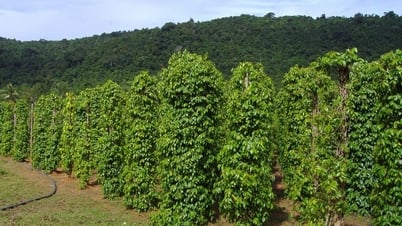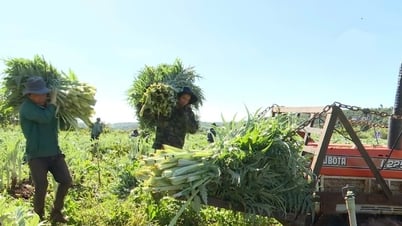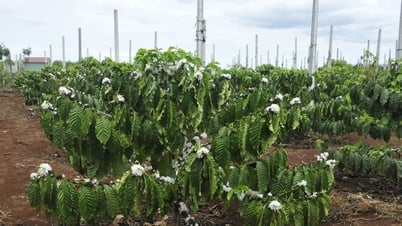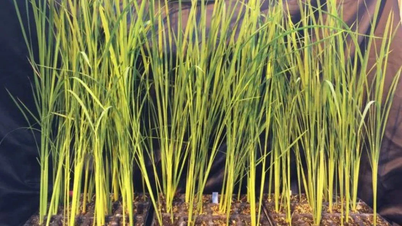Xuất khẩu nông lâm thủy sản luôn là điểm sáng trong “bức tranh” kinh tế Việt Nam. Chín tháng đầu năm 2024, tổng kim ngạch xuất khẩu các mặt hàng này đạt 46,28 tỷ USD, tăng 21%; giá trị xuất siêu đạt 13,86 tỷ USD, tăng 71,2% so với cùng kỳ 2023.
 |
| Sầu riêng là một trong những nông sản xuất khẩu chủ lực của Việt Nam. (Ảnh: Đào Ngọc Thạch) |
Là trụ đỡ của nền kinh tế, mỗi năm, xuất khẩu nông sản mang về cho Việt Nam hơn 50 tỷ USD. Năm nay, với việc xuất khẩu các mặt hàng chủ lực cao hơn năm ngoái, toàn ngành có nhiều động lực để sớm đạt mục tiêu 54-55 tỷ USD được giao.
Những con số ấn tượng
Theo số liệu của Bộ Nông nghiệp và Phát triển nông thôn (NN&PTNT), chín tháng đầu năm 2024, xuất khẩu nông sản tiếp tục phục hồi và tăng trưởng ấn tượng, đóng góp tích cực vào thặng dư thương mại. Tổng kim ngạch xuất khẩu nông lâm thủy sản đạt 46,28 tỷ USD, tăng 21%; nhập khẩu 32,42 tỷ USD, tăng 7,5%. Giá trị xuất siêu nông lâm thủy sản đạt 13,86 tỷ USD, tăng 71,2%.
Kim ngạch xuất khẩu các mặt hàng chủ lực đều cao hơn cùng kỳ năm ngoái như: gỗ và sản phẩm gỗ 11,66 tỷ USD, tăng 21,3%; cà phê 4,37 tỷ USD, tăng 39,6%; gạo 4,37 tỷ USD, tăng 23,5%, tăng 9,2%; hạt điều 3,17 tỷ USD, tăng 22,5%; rau quả 5,87 tỷ USD, tăng 39,4%; tôm 2,79 tỷ USD, tăng 10,5%; cá tra 1,36 tỷ USD, tăng 7,8%; hạt tiêu 1 tỷ USD, tăng 46,9%...
Đặc biệt, giá xuất khẩu bình quân của cà phê tăng cao nhất, với 56% và đạt 3.897 USD/tấn; đứng thứ hai là hạt tiêu tăng 49,2% và đạt 4.941 USD/tấn; tiếp đến là cao su tăng 19%, gạo tăng 13,1%… Ấn tượng hơn khi tháng 9/2024, xuất khẩu rau quả đạt 1,2 tỷ USD, tăng mạnh 72,5% so với cùng kỳ năm ngoái. Đây là lần đầu tiên ngành hàng rau quả ghi nhận kim ngạch xuất khẩu một tháng vượt mốc 1 tỷ USD, đưa kim ngạch xuất khẩu rau quả chín tháng đầu năm nay bằng kim ngạch cả năm 2023.
Không những vậy, giá trị nông sản xuất khẩu vào các thị trường tăng trưởng khá như: châu Á tăng 17,4%; châu Mỹ tăng 26,1%; châu Âu tăng 34,6%; châu Đại dương tăng 16,1%. Các thị trường Trung Quốc, Mỹ, Philippines, Nhật Bản và Hàn Quốc đều tăng mua nông sản Việt.
Nhiều động lực xuất khẩu
Theo các chuyên gia và hiệp hội ngành hàng, có được kết quả trên là nhờ hàng loạt giải pháp phát huy tác dụng, tạo động lực thúc đẩy xuất khẩu.
Thứ nhất, Việt Nam thực thi 16 hiệp định thương mại tự do (FTA), tạo cơ hội rất lớn cho xuất khẩu hàng hóa nói chung và nông sản nói riêng. Đặc biệt, nhờ tận dụng cơ hội và lợi thế thuế quan từ Hiệp định Đối tác toàn diện và tiến bộ xuyên Thái Bình Dương (CPTPP) và FTA Việt Nam - EU (EVFTA), xuất khẩu nông sản nước ta tăng trưởng mạnh.
Thứ hai, tính đến tháng 9/2024, các địa phương thiết lập và cấp 7.639 mã số vùng trồng tại 56 địa phương và 1.557 mã số cơ sở đóng gói được phép xuất khẩu sang Trung Quốc, Mỹ, Australia, New Zealand, Hàn Quốc, Nhật Bản, Liên minh châu Âu (EU)… góp phần định hướng sản xuất theo nhu cầu của thị trường, nâng cao uy tín của nông sản Việt.
Thứ ba, việc phê duyệt và triển khai đề án thúc đẩy xuất khẩu nông, lâm, thủy sản sang các thị trường lớn như Mỹ, Trung Quốc, Nhật Bản, EU... từ cuối năm 2023, kết hợp triển khai các giải pháp mở cửa thị trường, tìm kiếm các đơn hàng mới trong năm 2024 đã có hiệu quả.
Thứ tư, trong chuyến thăm cấp Nhà nước của Tổng Bí thư, Chủ tịch nước Tô Lâm đến Trung Quốc (tháng 8/2024), Bộ NN&PTNN và Tổng cục Hải quan Trung Quốc đã ký ba nghị định thư gồm: Kiểm tra, kiểm dịch thực vật và an toàn thực phẩm đối với sầu riêng đông lạnh xuất khẩu; yêu cầu kiểm dịch thực vật đối với dừa tươi xuất khẩu và yêu cầu kiểm dịch và sức khỏe đối với cá sấu nuôi... Việc này được kỳ vọng tiếp tục tạo thuận lợi cho nông sản Việt Nam “rộng cửa” hơn vào thị trường nền kinh tế lớn thứ hai thế giới.
Thứ năm, cũng trong tháng 8/2024, Việt Nam đã đạt thỏa thuận cho chanh dây nhập khẩu vào Mỹ. Hai nước khởi động quy trình xem xét sản phẩm mới của Việt Nam, gồm: chanh không hạt, ổi, mít, quýt, mận, chanh vàng, lựu và một số sản phẩm khác để làm giống cây trồng của phía Mỹ. Bộ Nông nghiệp Mỹ cho biết, nước này chưa có quan hệ hợp tác chặt chẽ như vậy với bất kỳ đối tác nào tại khu vực.
Hướng tới kỷ lục mới
Là nước nhiệt đới gió mùa, Việt Nam thu hoạch nông sản quanh năm. Tuy nhiên, theo các chuyên gia, hiện xuất khẩu các mặt hàng này phải đối mặt với nhiều thách thức như: yêu cầu về tiêu chuẩn chất lượng, xuất xứ hàng hóa của thị trường nhập khẩu ngày càng cao; những tác động tiêu cực của bệnh dịch, xung đột thương mại, xung đột địa chính trị, xu hướng bảo hộ…
Thứ trưởng Bộ NN&PTNT Phùng Đức Tiến nhận định, thời gian qua, mưa bão, thiên tai gây thiệt hại lớn cho ngành nông nghiệp khiến nguồn nguyên liệu sụt giảm trong khi giá cước vận tải biển tiếp tục tăng cao… Dự báo, biến đổi khí hậu không chỉ gây ra các hiện tượng thời tiết cực đoan như mưa đá, hạn hán, lũ lụt... mà còn ảnh hưởng nặng nề đến lĩnh vực nông nghiệp, làm giảm diện tích đất canh tác, giảm chất lượng và sản lượng, thậm chí có thể khiến mất mùa.
Mặt khác, trong xu thế phát triển bền vững, các thị trường xuất khẩu lớn như Mỹ, Nhật Bản, EU… đòi hỏi nông sản xuất khẩu đáp ứng tiêu chuẩn giảm phát thải carbon và bảo vệ môi trường.
Tất cả yếu tố trên đặt ra yêu cầu phải tìm giải pháp xuất khẩu nông nghiệp Việt Nam giữ vững sức tăng trưởng, đồng thời tiếp tục xác lập các con số kỷ lục.
Trao đổi với Báo Thế giới và Việt Nam, chuyên gia kinh tế, TS. Nguyễn Minh Phong cho rằng, Việt Nam hiện vẫn xuất khẩu nông sản thô, hàm lượng chế biến thấp, chiếm khoảng 70-80% tổng kim ngạch xuất khẩu, nên giá trị và mức độ cạnh tranh không cao. Vì vậy, để nông sản Việt Nam “hút” thêm nhiều ngoại tệ, trước tiên ngành nông nghiệp cấp thiết chuyển từ xuất khẩu thô sang gia tăng tỷ lệ xuất khẩu tinh.
Để làm được điều này, theo TS. Nguyễn Minh Phong, Nhà nước cần tiếp tục triển khai các chính sách hiện hành hỗ trợ cho doanh nghiệp ứng dụng khoa học công nghệ trong nông nghiệp, thu hút đầu tư phát triển ngành công nghiệp chế biến thực phẩm; khuyến khích doanh nghiệp đầu tư chế biến sâu để nâng cao giá trị và chất lượng. Ngoài ra, các doanh nghiệp cần đầu tư kiện toàn và nâng cấp các nhà máy chế biến hiện có, nâng cấp công nghệ đảm bảo chất lượng và an toàn thực phẩm; xây dựng hệ thống kho bảo quản đáp ứng yêu cầu cho chuỗi cung ứng, bảo đảm duy trì chất lượng sản phẩm…
Trong khi đó, Thứ trưởng Phùng Đức Tiến khuyến nghị các doanh nghiệp đã có năng lực chế biến sâu cần tập trung xây dựng thương hiệu để nông sản Việt thực sự có giá trị trên thị trường quốc tế; đẩy mạnh xúc tiến thương mại, giới thiệu những sản phẩm nông sản có lợi thế; tiếp tục thúc đẩy tái cơ cấu ngành nông nghiệp theo chiến lược đã đề ra.
Nhằm tiếp cận và giữ vững những thị trường khó tính, hàng hóa xuất khẩu, đặc biệt là nông sản, phải đáp ứng quy chuẩn về nguồn gốc, chất lượng. Do đó, TS. Nguyễn Minh Phong nhấn mạnh yếu tố đáp ứng vệ sinh an toàn thực phẩm, hàng rào kỹ thuật. “Việc chủ động đáp ứng tất cả các thị trường là rất quan trọng. Trong bối cảnh kinh tế thế giới biến động, rất rủi ro khi phụ thuộc vào một vài thị trường nhất định. Do vậy, nông sản Việt Nam cần nâng cao chất lượng để trong trường hợp một thị trường biến động hoặc có những thị trường khác nổi lên, ta có thể chuyển đổi để bán hàng, tăng trưởng bền vững”, ông Phong nói.
Chỉ có con đường nâng cao chất lượng, nông sản mới có thể “mở cửa” vào các thị trường mới, nhiều tiềm năng như các nước Trung Đông, châu Phi, các quốc gia Hồi giáo, thị trường Halal...
Cuối cùng, phát triển nông nghiệp xanh là một xu hướng tất yếu và yêu cầu bắt buộc trong bối cảnh hội nhập quốc tế hiện nay. Các chuyên gia khẳng định, ngay từ bây giờ, người dân và doanh nghiệp cần tiếp tục chuyển từ phát triển chuỗi cung ứng nông sản sang phát triển chuỗi giá trị ngành hàng và phát triển nông nghiệp xanh mới có thể bắt nhịp xu hướng tiêu dùng của thị trường toàn cầu.
Nguồn: https://baoquocte.vn/con-duong-mo-ra-canh-cua-moi-cho-nong-san-289682.html










































































































Bình luận (0)